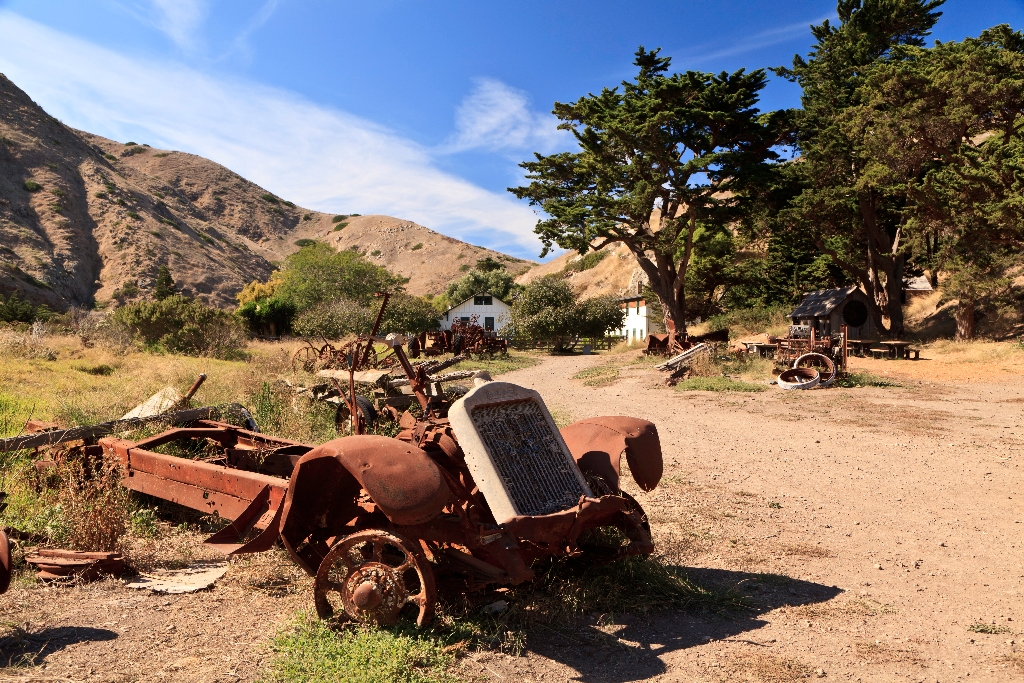
The farm implements on display throughout the Scorpion ranch historic area reveal a period in island history that is hard to imagine in today's technologically advanced world. A period of horse-drawn equipment such as plows, mowers, and hay balers. A period when repairs to this equipment along with the manufacturing of iron fittings, railings, hinges, and other materials were done by a resident blacksmith. A period of self-reliance-of homemade sawmills and other modified equipment that demonstrate how those living on the island adapted to the difficulties of isolated island life and, as former ranch superintendent Clifford McElrath states in On Santa Cruz Island, "learned to make do with what [they] had."
Some of this equipment dates back to the Justinian Caire era that began in the early1880s. At that time Caire started developing a large island agricultural community that "included the production of wine, wool, tallow, meat, and olives." (Gherini, p. 84) One can well imagine that "the developments of an island rancho (covering 62,000 acres) presented a formidable logistical problem of transporting large quantities of supplies to and from the island located twenty miles off the coast of California." (Gherini, p. 81)
By the 1890s, Caire raised over 50,000 sheep, harvested 150 acres of vineyards, and planted olive orchards, eucalyptus groves, and extensive gardens. By 1900 wagons, carts, horse hay rakes, hay presses, mowers, gang plows, breaking plows, cultivators, barley seeders, anvils, drills, harrows, windmills, water pumps, and other pieces of equipment were commonplace. Over a hundred horses provided the power to pull the equipment. Later, tractors such as the "Waterloo Boy" would replace the horses and provide the power to pull the equipment.
Caire's ranching agricultural enterprise featured ten sub ranches on the island. Scorpion and Smugglers, known as the granary, played an important part in this ranching system since the vast plateaus of the east end "supported a variety of crops such as wheat, corn, potatoes, beans, barley, and onions, besides hay and alfalfa." (Gherini, p. 95) Ranch hands tended to flocks of sheep and to a small herd of cattle as well as performing the arduous task of building roads and rock walls. To make better use of the land for planting, "workers cleared the fields of rocks; then they piled the huge rocks into cairns which remain today as a monument to their labor." (Gherini, p. 100) In one way or another, many of the farm implements on display helped in the establishment of a unique island rancho.
Ranching continued on the eastern end of Santa Cruz Island until 1984. Between 1926 and 1984, the Gherini family, descendants of Justinian Caire, operated a sheep ranch for meat and wool out of the Scorpion Ranch area. This era ended in February 1997 when the National Park Service acquired the last interest from the Gherini family. Today, the National Park Service is preserving this historic area so visitors always will have the chance to remember and understand this unique part of the island's past.
As you walk throughout this historic area use the Farm Implements Self-guided Tour (under "Tours") or the Interpretive Guide to Eastern Santa Cruz Island (available in the orientation area) to locate the various farm implements. The numbers on the map mark the location of the farm implements described in this guide.
How did the implements get to the island?
Transporting equipment and supplies across twenty miles of ocean presented difficult logistical problems. "The task of unloading at Scorpion Harbor could be difficult and potentially dangerous especially when unloading heavy equipment." (Gherini, p.199) The owners often used barges or lighters to off-load heavy equipment such as the Waterloo Boy in 1918 and the Caterpillar 30 in 1938. When off-loading the Caterpillar 30 it tipped over.
In another instance, in the 1950s, the Natco, a 42-foot boat owned by the Gherini family to haul supplies to the island, carried parts and new tracks for the Caterpillar 30. The Natco took on water several miles from the island and nearly sank. The Coast Guard came to the rescue and towed the Natco back to Santa Barbara. In 1975, "a pick-up truck was being off-loaded from the Hodge. The ocean surged around the cement pier, and as the boat's boom lifted the truck from the deck and swung it over to the pier, the boom snapped like a toothpick. The truck dropped into the ocean and became another island relic." (Gherini, p.200) Today, the National Park Service uses a landing craft to bring heavy equipment to the island.
Is there something we missed for this itinerary?
Itineraries across USA


















































